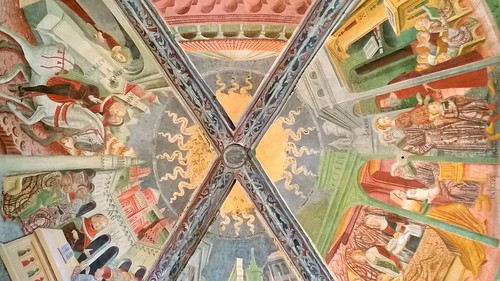Þjóðhildarkirkja (Thjodhild’s church) in Brattahlíð, south-west Greenland.
Brattahlíð (the name means “the steep slope”) was Erik the Red’s estate in the Eastern Settlement Viking colony he established in south-western Greenland toward the end of the 10th century. The present settlement of Qassiarsuk is now located in its place. The site is located about 96 km (60 mi) from the ocean, at the head of the Tunulliarfik Fjord (Eriksfjord), and hence sheltered from ocean storms. Erik and his descendants lived there until about the mid-15th century.
Brattahlíð hosted the first Greenlandic Þing (parliament), based on the Icelandic Althing.
Erik the Red was the first permanent European settler in Greenland. In 982, Erik, outlawed for three years from Iceland, sailed to a mysterious western land. He rounded the southern tip of the island (later known as Cape Farewell) and sailed up the western coast. He eventually reached a part of the coast that, for the most part, seemed ice-free and consequently had conditions—similar to those of Iceland—that promised growth and future prosperity (at that time temperatures were milder and glaciers much more retreated inland). According to the Saga of Erik the Red, he spent his three years of exile exploring this land.
When Erik returned to Iceland after his exile had expired, he is said to have brought with him stories of “Greenland”. Erik deliberately gave the land an appealing name in order to lure potential settlers. His salesmanship proved successful, as many people became convinced that Greenland held great opportunity.
After spending the winter in Iceland, Erik returned to Greenland in 985 with a large number of colonists. The Icelanders established two colonies on the southwest coast: the Eastern Settlement or Eystribyggð, and the Western Settlement or Vestribyggð, close to present-day Nuuk, further north. The Eastern and Western Settlements, both established on the southwest coast, proved the only areas suitable for farming.
In Eystribyggð or Eastern Settlement, Erik built the estate of Brattahlíð. He held the title of paramount chieftain of Greenland and became both greatly respected and wealthy.
The settlement flourished, growing to 5000 inhabitants spread over a considerable area along Eriksfjord and neighboring fjords. Groups of immigrants escaping overcrowding in Iceland joined the original party. As the Western settlement, the colony thrived and survived until the Little Ice Age made the land marginal for European life-styles in the 15th century (shortly before Christopher Columbus’s first voyage to the Americas in 1492).








